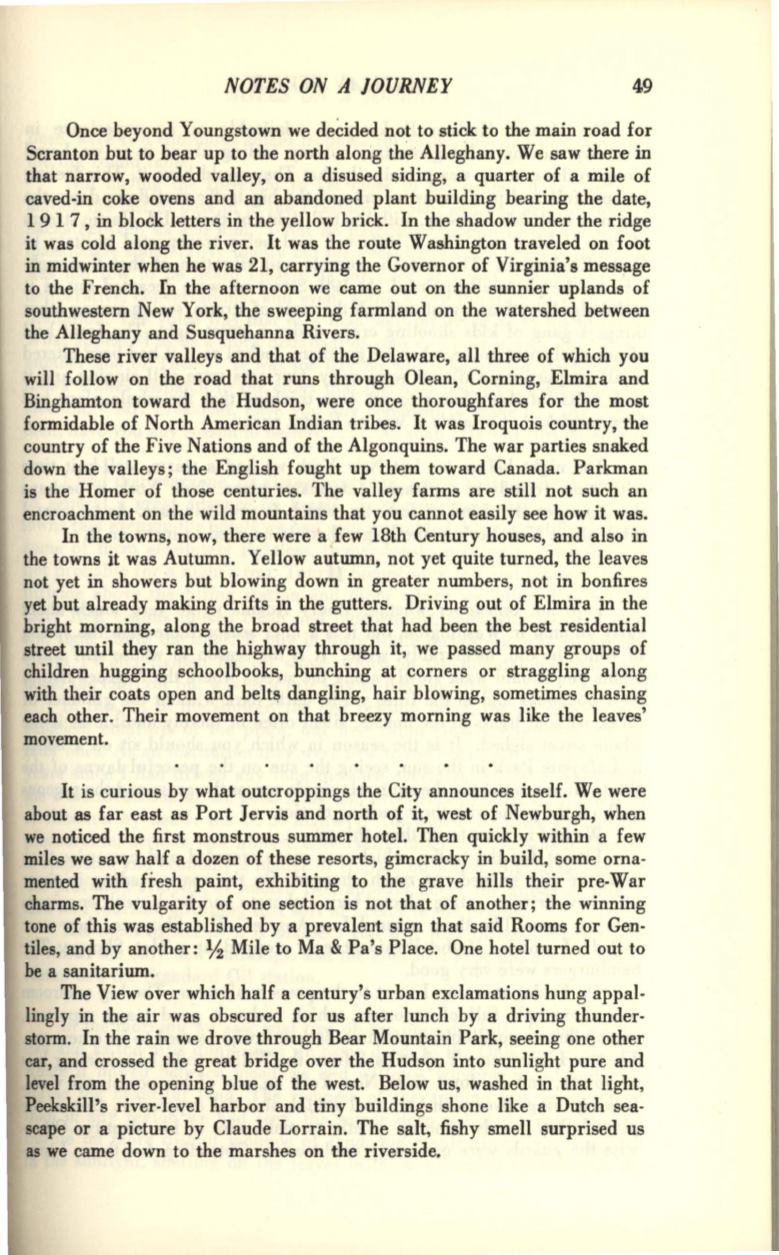
NOTES ON A JOURNEY
49
Once beyond Youngstown we
de~ided
not to stick to the main road for
Scranton but to bear up to the north alorig the Alleghany. We saw there in
that narrow, wooded valley, on a disused siding, a quarter of a mile of
caved-in coke ovens and an abandoned plant building bearing the date,
l
9
l
7 , in block letters in the yellow brick. In the shadow under the ridge
it was cold along the river. It was the route Washington traveled on foot
in midwinter when he was 21, carrying the Governor of Virginia's message
to the French. In the afternoon we came out on the sunnier uplands of
southwestern New York, the sweeping farmland on the watershed between
the Alleghany and Susquehanna Rivers.
These river valleys and that of the Delaware, all three of which you
will follow on the road that runs through Olean, Corning, Elmira and
Binghamton toward the Hudson, were once thoroughfares for the most
formidable of North American Indian tribes. It was Iroquois country, the
country of the Five Nations and of the Algonquins. The war parties snaked
down the valleys; the English fought up them toward Canada. Parkman
is the Homer of those centuries. The valley farms are still not such an
encroachment on the wild mountains that you cannot easily see how it was.
In the towns, now, there were a few 18th Century houses, and also in
the towns it was Autumn. Yellow autumn, not yet quite turned, the leaves
not yet in showers but blowing down in greater numbers, not in bonfires
yet
but already making drifts in the gutters. Driving out of Elmira in the
bright morning, along the broad street that had been the best residential
street until they ran the highway through it, we passed many groups of
children hugging schoolbooks, bunching at corners or straggling along
with their coats open and belts dangling, hair blowing, sometimes chasing
each other. Their movement on that breezy morning was like the leaves'
movement.
It
is curious by what outcroppings the City announces itself. We were
about as far east as Port Jervis and north of it, west of Newburgh, when
we noticed the first monstrous summer hotel. Then quickly within a few
miles we saw half a dozen of these resorts, gimcracky in build, some orna·
mented with fresh paint, exhibiting to the grave hills their pre-War
charms. The vulgarity of one section is not that of another; the winning
tone of this was established by a prevalent sign that said Rooms for Gen·
tiles, and by another:
'f2
Mile to Ma
&
Pa's Place. One hotel turned out to
be
a sanitarium.
The View over which half a century's urban exclamations hung appal·
lingly in the air was obscured for us after lunch by a driving thunder·
storm. In the rain we drove through Bear Mountain Park, seeing one other
car, and crossed the great bridge over the Hudson into sunlight pure and
level from the opening blue of the west. Below us, washed in that light,
Peekskill's river-level harbor and tiny buildings shone like a Dutch sea·
scape or a picture by Claude Lorrain. The salt, fishy smell surprised us
as
we came down to the marshes on the riverside.


